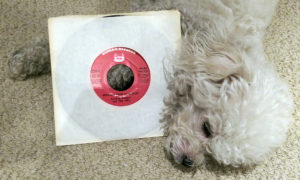Our story begins in 1970 with a phone call placed by singer-songwriter Jim Weatherly to his friend, actor Lee Majors. Pre-The Six Million Dollar Man Majors was dating pre-Charlie’s Angels actress Farrah Fawcett. Fawcett answered the phone and while chatting with Weatherly, mentioned she was leaving that night to visit her parents in Texas. She told him she was taking the midnight plane to Houston.
That phrase stuck with Weatherly, who immediately upon hanging up the phone, turned it into a song. He recorded “Midnight Plane to Houston” for his 1972 album, Weatherly. Among the album’s other tracks was another song he wrote, entitled “Neither One of Us (Wants to Be the First to Say Goodbye).”
It was the latter song that first made its way to Gladys Knight & the Pips. Their recording of it reached #2 on the Billboard Hot 100, and was their biggest-selling single for Motown. It also turned out to be their last single released on Motown while still signed to the label.
The group had been with Motown since 1966. While “Neither One of Us” was on the charts, negotiations for a better deal with the label fell through, and the group was quickly scooped up by Buddah Records. As songwriter Jim Weatherly just provided them with a huge hit, they looked for more Weatherly compositions to record for their debut album for Buddah. You may see where this is going, but let’s backtrack for a moment.
“Midnight Plane to Houston” found its way to Cissy Houston, r&b/gospel singer and mother to Whitney Houston. Cissy liked the song, but asked Weatherly if she can make some changes. Specifically, her family was from Georgia, so she asked if she could switch Houston to Georgia. Also, her family didn’t fly; they rode trains. Weatherly had no objection to the requested changes, so in 1972, Cissy Houston recorded “Midnite Train to Georgia.”
It was this revised version that made its way to Gladys Knight & the Pips, who also hail from Georgia. The lyrics resonated with Knight. Like the partner about whom the song’s protagonist sings, Knight’s husband at that time was a musician. Perhaps he kept dreaming that someday he’d be a star, a superstar, but he didn’t get far. Unlike the song’s protagonist, Knight didn’t choose to live in his world than live without him in hers. The couple divorced in 1973, the same year that Gladys Knight & the Pips scored their first #1 pop single with “Midnight Train to Georgia,” which knocked the Rolling Stones’ “Angie” from the top slot. “Midnight Train” won the group the Grammy Award for Best R&B Vocal Performance by a Group.

Twelve years after the group’s first top ten pop hit, 1961’s “Every Beat of My Heart,” Gladys Knight & the Pips went on hit-making roll, following up “Midnight” with three consecutive top ten hits: “I’ve Got to Use My Imagination,” “On and On,” and another Weatherly composition, “Best Thing That Ever Happened to Me.”
Today Gladys Knight turns 72 years old. Tunes du Jour celebrates the occasion with twenty of her group’s finest.
Click here to like Tunes du Jour on Facebook!
Follow me on Twitter: @TunesDuJour
Follow me on Instagram: Glenn.Schwartz99

